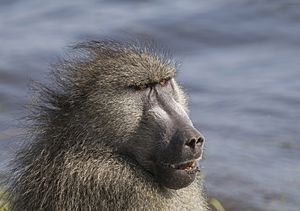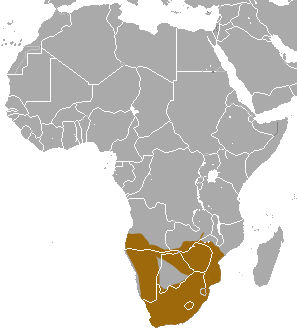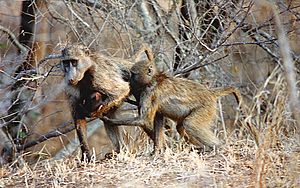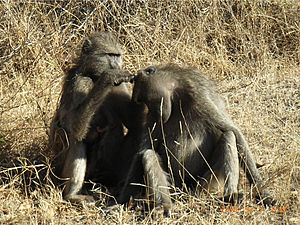Chacma baboon facts for kids
Quick facts for kids Chacma baboon |
|
|---|---|
 |
|
| Male P. u. griseipes, Chobe National Park, Botswana | |
| Conservation status | |
| Scientific classification | |
| Genus: |
Papio
|
| Species: |
ursinus
|
| Subspecies | |
|
3 ssp., see text |
|
 |
|
| Geographic range | |
The chacma baboon (Papio ursinus), also known as the Cape baboon, is a type of baboon. Like all baboons, it belongs to the Old World monkey family. It is one of the biggest monkeys in the world.
Chacma baboons mostly live in southern Africa. They have many interesting social behaviors. These include a pecking order (dominance hierarchy), looking for food together, and even adopting young baboons. They also form special friendships. While the species is generally not in danger, more people living near them means more contact. This can lead to baboons being hunted or getting into accidents, which affects their numbers and social groups.
Contents
Physical Features of the Chacma Baboon
The chacma baboon might be the longest monkey species. Males can be about 50 to 115 cm (20 to 45 in) long. Their tails add another 45 to 84 cm (18 to 33 in). They are also very heavy. A male can weigh from 21 to 45 kg (46 to 99 lb). The average male weighs about 31.8 kg (70 lb).
Chacma baboons show sexual dimorphism. This means males and females look different. Females are much smaller than males. A female chacma weighs from 12 to 25 kg (26 to 55 lb). Her average weight is about 15.4 kg (34 lb).
The chacma baboon is similar in size to the olive baboon. It is also similar in weight to the mandrill. Some people say the mandrill is the largest monkey. However, the chacma baboon seems to be the largest living monkey based on total length and average weight.
Chacma baboons are usually dark brown to gray. They have a patch of rough hair on the back of their neck. Unlike some baboons, male chacmas do not have a mane (long hair around their neck). Their most unique feature is their long face that slopes downwards.
The three subspecies of chacma baboons look a bit different. They vary in size and color. The Cape chacma is large, heavy, and dark brown. It also has black feet. The gray-footed chacma is a bit smaller and lighter in color. It has gray feet. The Ruacana chacma is generally smaller and less dark than the Cape chacma.
Where Chacma Baboons Live and What They Eat
Homes and Where They Are Found
Chacma baboons live in many different places. These include woodlands, savannas, and even deserts. They can be found from the grassy mountains of the Drakensberg to the Kalahari Desert.
At night, chacma baboons sleep in safe spots. They choose steep hills, high cliffs, large rocks, or tall trees. This keeps them safe from predators. During the day, finding water can limit where they can go in dry areas.
You can find chacma baboons all over southern Africa. Their range goes from South Africa up to Angola, Zambia, and Mozambique. The different subspecies live in specific parts of this area. The Cape chacma lives in southern South Africa. The gray-footed chacma is found from northern South Africa, through the Okavango Delta in Botswana, Zimbabwe, and Mozambique. It also lives in southwest Zambia. The Ruacana chacma lives in northern Namibia and southern Angola.
What They Eat
The chacma baboon is an omnivore. This means it eats both plants and animals. They are opportunistic feeders, so they will eat almost anything they find.
Their typical foods include fruits, seeds, grass, and flowers. They also eat bulbs, tree bark, insects, and worms. Sometimes they eat small animals like rodents, birds, and even small antelope. Fungi, like the desert truffle, are also on their menu.
Chacma baboons enjoy eating various crops from farms. They might also kill and eat sheep, goats, and chickens. Because of this, many African farmers see them as a problem. At the Cape of Good Hope, chacma baboons are known to eat shellfish and other small sea creatures. They usually scavenge for meat, meaning they eat animals that are already dead. They rarely hunt larger animals themselves. Normally, wild chacma baboons run away when people come near. However, this is changing in areas where they can easily find food and garbage from human homes.
How Chacma Baboons Behave
Living in Groups
Chacma baboons usually live in social groups called troops. These troops have many adult males, adult females, and their young. Sometimes, very small groups form with just one adult male and a few adult females.
Chacma troops have a dominance hierarchy, which is like a pecking order. A female's rank in the troop is passed down from her mother. This rank usually stays the same. However, a male's rank often changes, especially when a new dominant male takes over.
Chacmas are a bit different from other baboons. Males and females don't form very strong bonds with others of the same sex. Instead, the strongest friendships are often between unrelated adult males and females. Baboon troops have complex group behaviors. They communicate using body language, facial expressions, sounds, and touch.
Leaving the Sleeping Site in the Morning
Chacma baboons often sleep in large groups at night. They choose high rocks, cliffs, or trees to stay safe from predators. In the morning, everyone leaves the sleeping site at the same time. One baboon usually starts to leave, and the others decide whether to follow. At least five other baboons need to follow for a successful departure. Not all attempts to leave are successful.
It's interesting that the baboon who starts to leave isn't always the most dominant one. More dominant baboons are not more likely to lead a successful departure than less dominant ones.
Baboons who are more involved in the group are more likely to be followed. This means baboons who spend more time grooming and interacting with others are better leaders. This shows that group members are more likely to follow those they are close to.
Finding Food Together
Dominance does play a role when the group decides where to find food. A dominant baboon, usually the alpha male, leads the group to food sources that are easy to control. The group usually follows, even if many lower-ranking members can't get to that food. Just like when leaving the sleeping site, baboons are more likely to follow a dominant leader if they have strong social connections with them.
Sometimes, many baboons look for food together. This is called collective foraging. This behavior often happens because they all need the same kind of food. For example, pregnant females often look for food at the same time because they have similar dietary needs. When there isn't much food around, baboons don't forage together as much.
Adopting Young Baboons
Chacma baboons have been seen adopting young baboons. Orphaned baboons, whose mothers have disappeared or died, are often too small to take care of themselves. In one study, almost all orphaned baboons were adopted by another member of the group.
Friendships Between Baboons

Male and female chacma baboons often form special relationships called "friendships." Females are thought to seek out male friends to get protection.
Studies on stress levels in female baboons support this idea. When a new male becomes the dominant leader, stress levels in pregnant and nursing females go up. However, females who have male friends show a smaller increase in stress. This suggests that male friends offer some protection.
The benefits for males are not as clear. A male is more likely to be friends with females he has mated with. This might mean males form friendships to protect their own offspring. They might also want to protect the female's future babies.
Female chacma baboons have been seen competing with each other for male friends. This might happen if one male has a high chance of being the father of many females' babies. These competitions are strongly affected by the female dominance hierarchy. More dominant females can often take over friendships with males from less dominant females.
Images for kids
-
P. u. ursinus
Cape of Good Hope, South Africa -
Male P. u. griseipes
Chobe National Park, Botswana -
Male in Kruger National Park, South Africa
See also
 In Spanish: Papión chacma para niños
In Spanish: Papión chacma para niños











